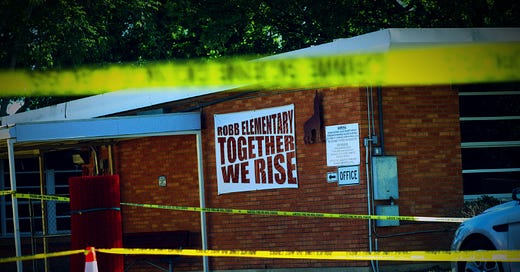"It's Made Me Doubt My Future In Education"
Copycat threats in the wake of Uvalde have teachers at the breaking point
Student threats of violence have increased in the two weeks since the Uvalde, Texas elementary school massacre, teachers say, an added stressor on children who already are in a heightened state of alert in the classroom.
The copycat phenomenon only lasts about two weeks. But for that period of time, teachers and students are under severe stress.
A 10-year-old in Cape Coral, Florida was arrested on May 28 after making threats via text. In Texas, Axios reports that a rash of threats and weapons brought to school have officials on edge. A Maryland teenager brought parts of a ghost gun to school. A New York student was arrested for threatening a “massive shooting.” And on and on, all around the country.
“It’s made me doubt my future in education,” Emily, a teacher in Southern California, told me. “Right now, I plan on transitioning out in the next two or so years.”
Emily, who has seen lockdowns for credible threats at nearby districts since Uvalde, teaches first grade. Since the shooting she’s seen just how parents and the community view her and her role in their children’s lives—as something of a protector.
At an Open House that came the night after the Uvalde shooting, Emily said that a number of parents came up to her privately to hold her hand and tell her how much they appreciated her. While she knows it was well meant, Emily still couldn’t help but feel like she was “a soldier about to leave for active duty.”
“It made me realize how people see teachers now,” she said. “It was scary.”
Not all schools are taking things as seriously as some teachers think they should. John, an 8th-grade teacher on Long Island, said that before Uvalde at the school he teaches at a student had a switchblade fall out of his bag during class and was just sent home and marked absent. “There was no formal discipline,” John said.
Since the Uvalde massacre, there have been threats but the school hasn’t made dealing with them a priority. Some high school students took a picture of a gun wrapped in a rainbow flag and posted the image on social media. The school still took over an hour to take action.
“There have also been a number of instances where neighboring districts go on lockdown and we just don't,” John said. “Our superintendent is huge on optics. He doesn’t like repeating things to the state because it tarnishes the already bad reputation of our district.”
Dan, a middle school teacher in the Chicago suburbs, found the same. There have been two separate incidents since Uvalde that resulted in a soft lockdown and an expulsion. The soft lockdown was for a bomb threat in a neighboring district that turned out to be a hoax. The expulsion was for a direct threat made to the school. It was quickly wrapped up and brushed aside, in Dan’s view.
“The student who made the ‘threatening statement’ and the friend who was telling everyone about the statement were sent home for the remaining two days of the school year,” Dan said. “It was ruled a joke after the police investigated.”
At least two students in Jane’s upstate New York school made threats on social media after the massacre, and police have searched the school for weapons at least once. Kids are taking it in stride, but student normalization of the threat level has Jane worried.
“In my study hall [the kids] mentioned, very casually, people talking on social media about shooting up the school,” she said.
The nonchalant attitude is disturbing.
“There was no fear in their voices,” Jane said. “Either they didn't take it seriously or it's just so normalized that it doesn't rattle them.”
Emily’s first-graders are aware of what happened in Texas, but they see it in matter-of-fact terms. And they’re still young enough that they can be reassured.
“I haven’t been trained on how to address these sorts of things with students, so I end up lying to them that they’re 100% safe at school,” Emily said. “Obviously I wouldn’t tell them any different because they’re six and seven, but I still feel guilty because it’s not entirely true.”
If you would like to support my work, please consider a paid subscription
Find me on Twitter and Facebook
Email me at eoinhiggins@gmail.com




